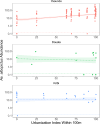The effects of urbanization, temperature, and rainfall on Aedes aegypti and Aedes albopictus mosquito abundance across a broad latitudinal gradient in Central Africa
- PMID: 40189559
- PMCID: PMC11972486
- DOI: 10.1186/s13071-025-06764-5
The effects of urbanization, temperature, and rainfall on Aedes aegypti and Aedes albopictus mosquito abundance across a broad latitudinal gradient in Central Africa
Abstract
Background: Urbanization can influence disease vectors by altering larval habitat, microclimates, and host abundance. The global increase in urbanization, especially in Africa, is likely to alter vector abundance and pathogen transmission. We investigated the effect of urbanization and weather on the abundance of two mosquitoes, Aedes aegypti and Aedes albopictus, and infection with dengue, chikungunya, and Zika viruses at 63 sites in six cities spanning a 900-km latitudinal range in Cameroon, Central Africa.
Methods: We used human landing catches and backpack-mounted aspirators to sample mosquitoes and collected larval habitat, host availability, and weather (temperature, precipitation, humidity) data for each site in each city. We analyzed land use and land cover information and satellite photos at varying radii around sites (100 m to 2 km) to quantify the extent of urbanization and the number of structures around each site. We used a continuous urbanization index (UI; range 0-100) that increased with impermeable surface and decreased with forest cover.
Results: Urbanization increased larval habitat, human host availability, and Ae. aegypti mosquito abundance. Aedes aegypti abundance increased 1.7% (95% CI 0.69-2.7%) with each 1 unit increase in the urbanization index in all six cities (Douala, Kribi, Yaounde, Ngaoundere, Garoua, and Maroua) with a 5.4-fold increase from UI = 0 to UI = 100, and also increased with rainfall. In contrast, Ae. albopictus abundance increased with urbanization in one city, but showed no influence of urbanization in two other cites. Across three cities, Ae. albopictus abundance increased with rainfall, temperature, and humidity. Finally, we did not detect Zika, dengue, or chikungunya viruses in any specimens, and found weak evidence of interspecific competition in analyses of adult population growth rates.
Conclusions: These results show that urbanization consistently increases Ae. aegypti abundance across a broad range of habitats in Central Africa, while effects on Ae. albopictus were more variable and the abundance of both species were influenced by rainfall. Future urbanization of Africa will likely increase Ae. aegypti abundance, and climate change will likely alter abundance of both species through changes in precipitation and temperature.
Keywords: Africa; Arbovirus; Climate change; Mosquito; Urbanization; Vector-borne disease.
© 2025. The Author(s).
Conflict of interest statement
Declarations. Ethics approval and consent to participate: Not applicable. Consent for publication: Not applicable. Competing interests: The authors declare no competing interests.
Figures





References
-
- Grimm NB, Faeth SH, Golubiewski NE, Redman CL, Wu J, Bai X, et al. Global change and the ecology of cities. Science. 2008;319:756–60. - PubMed
-
- McKinney ML. Urbanization as a major cause of biotic homogenization. Biol Cons. 2006;127:247–60.
-
- Deilami K, Kamruzzaman Md, Liu Y. Urban heat island effect: a systematic review of spatio-temporal factors, data, methods, and mitigation measures. Int J Appl Earth Observ Geoinf. 2018;67:30–42.
-
- Gottdenker NL, Streicker DG, Faust CL, Carroll CR. Anthropogenic land use change and infectious diseases: a review of the evidence. EcoHealth. 2014;11:619–32. - PubMed
MeSH terms
Supplementary concepts
Grants and funding
LinkOut - more resources
Full Text Sources

